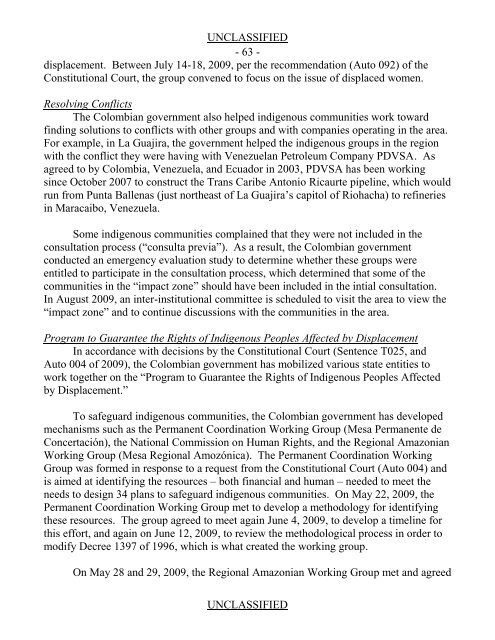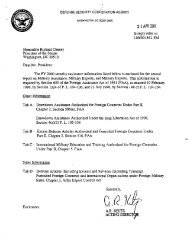memorandum of justification concerning human ... - Just the Facts
memorandum of justification concerning human ... - Just the Facts
memorandum of justification concerning human ... - Just the Facts
Create successful ePaper yourself
Turn your PDF publications into a flip-book with our unique Google optimized e-Paper software.
UNCLASSIFIED<br />
- 63 -<br />
displacement. Between July 14-18, 2009, per <strong>the</strong> recommendation (Auto 092) <strong>of</strong> <strong>the</strong><br />
Constitutional Court, <strong>the</strong> group convened to focus on <strong>the</strong> issue <strong>of</strong> displaced women.<br />
Resolving Conflicts<br />
The Colombian government also helped indigenous communities work toward<br />
finding solutions to conflicts with o<strong>the</strong>r groups and with companies operating in <strong>the</strong> area.<br />
For example, in La Guajira, <strong>the</strong> government helped <strong>the</strong> indigenous groups in <strong>the</strong> region<br />
with <strong>the</strong> conflict <strong>the</strong>y were having with Venezuelan Petroleum Company PDVSA. As<br />
agreed to by Colombia, Venezuela, and Ecuador in 2003, PDVSA has been working<br />
since October 2007 to construct <strong>the</strong> Trans Caribe Antonio Ricaurte pipeline, which would<br />
run from Punta Ballenas (just nor<strong>the</strong>ast <strong>of</strong> La Guajira‘s capitol <strong>of</strong> Riohacha) to refineries<br />
in Maracaibo, Venezuela.<br />
Some indigenous communities complained that <strong>the</strong>y were not included in <strong>the</strong><br />
consultation process (―consulta previa‖). As a result, <strong>the</strong> Colombian government<br />
conducted an emergency evaluation study to determine whe<strong>the</strong>r <strong>the</strong>se groups were<br />
entitled to participate in <strong>the</strong> consultation process, which determined that some <strong>of</strong> <strong>the</strong><br />
communities in <strong>the</strong> ―impact zone‖ should have been included in <strong>the</strong> intial consultation.<br />
In August 2009, an inter-institutional committee is scheduled to visit <strong>the</strong> area to view <strong>the</strong><br />
―impact zone‖ and to continue discussions with <strong>the</strong> communities in <strong>the</strong> area.<br />
Program to Guarantee <strong>the</strong> Rights <strong>of</strong> Indigenous Peoples Affected by Displacement<br />
In accordance with decisions by <strong>the</strong> Constitutional Court (Sentence T025, and<br />
Auto 004 <strong>of</strong> 2009), <strong>the</strong> Colombian government has mobilized various state entities to<br />
work toge<strong>the</strong>r on <strong>the</strong> ―Program to Guarantee <strong>the</strong> Rights <strong>of</strong> Indigenous Peoples Affected<br />
by Displacement.‖<br />
To safeguard indigenous communities, <strong>the</strong> Colombian government has developed<br />
mechanisms such as <strong>the</strong> Permanent Coordination Working Group (Mesa Permanente de<br />
Concertación), <strong>the</strong> National Commission on Human Rights, and <strong>the</strong> Regional Amazonian<br />
Working Group (Mesa Regional Amozónica). The Permanent Coordination Working<br />
Group was formed in response to a request from <strong>the</strong> Constitutional Court (Auto 004) and<br />
is aimed at identifying <strong>the</strong> resources – both financial and <strong>human</strong> – needed to meet <strong>the</strong><br />
needs to design 34 plans to safeguard indigenous communities. On May 22, 2009, <strong>the</strong><br />
Permanent Coordination Working Group met to develop a methodology for identifying<br />
<strong>the</strong>se resources. The group agreed to meet again June 4, 2009, to develop a timeline for<br />
this effort, and again on June 12, 2009, to review <strong>the</strong> methodological process in order to<br />
modify Decree 1397 <strong>of</strong> 1996, which is what created <strong>the</strong> working group.<br />
On May 28 and 29, 2009, <strong>the</strong> Regional Amazonian Working Group met and agreed<br />
UNCLASSIFIED



